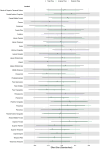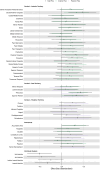Phase contrast-derived cerebral blood flow is associated with neurodegeneration and cerebrovascular injury in older adults
- PMID: 40688417
- PMCID: PMC12271140
- DOI: 10.3389/fnins.2025.1538956
Phase contrast-derived cerebral blood flow is associated with neurodegeneration and cerebrovascular injury in older adults
Abstract
Global cerebral blood flow and the local delivery of blood through the vascular network are essential to maintain brain and cognitive health throughout the lifespan. In this cross-sectional study, we examined the association of extracranial blood flow into the brain, measured with phase contrast magnetic resonance imaging, with regional brain volumes, cortical thickness, white matter tract integrity, white matter hyperintensity volume, and cerebral microbleeds. Our study included 311 older adults (mean age: 77 years, standard deviation: 5.6) from the Washington Heights Inwood Columbia Aging Project (WHICAP), a community-based study in northern Manhattan. We found that lower extracranial cerebral blood flow is associated with lower cortical regional volumes, lower white matter tract integrity, and higher white matter hyperintensity volume. We observed that lower extracranial cerebral blood flow, quantified by total, anterior, and posterior circulations, is associated with lower white matter tract integrity in the forceps minor, cingulum cingulate gyrus, and inferior fronto-occipital fasciculus. Additionally, lower total extracranial cerebral blood flow is associated with higher white matter hyperintensity volume, a marker of small vessel cerebrovascular disease. These findings support our hypothesis that lower extracranial cerebral blood flow is associated with a greater degree of vascular brain injury and indicators of neurodegeneration and are consistent with the guiding conceptual framework that diminished extracranial blood flow could be a factor that promotes or exacerbates neurodegeneration and cerebrovascular injury in older adults. Future longitudinal studies are needed to establish causality and temporality.
Keywords: aging; cerebral blood flow; cerebrovascular; hypoperfusion; phase contrast MRI; white matter.
Copyright © 2025 Pyne, Morales, Kraal, Alshikho, Lao, Turney, Amarante, Lippert, Chang, Gutierrez, Manly, Mayeux and Brickman.
Conflict of interest statement
AMB is an inventor of a patent for white matter hyperintensity quantification (US Patent US9867566B2). The remaining authors declare that the research was conducted in the absence of any commercial or financial relationships that could be construed as a potential conflict of interest.
Figures






References
-
- Alsop D. C., Detre J. A., Golay X., Günther M., Hendrikse J., Hernandez-Garcia L., et al. (2015). Recommended implementation of arterial spin-labeled perfusion MRI for clinical applications: a consensus of the ISMRM perfusion study group and the European consortium for ASL in dementia. Magn. Reson. Med. 73, 102–116. doi: 10.1002/mrm.25197, PMID: - DOI - PMC - PubMed
LinkOut - more resources
Full Text Sources

